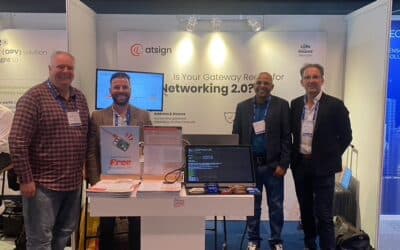ARTICLE
AI Sprawl: The Network Nightmare Caused by the AI Security Paradox
The promise of enterprise AI is simple: automate complex tasks and drive radical efficiency. The reality, however, is that every attempt to make AI secure and accurate creates a complex, decentralized, and potentially unmanageable network problem we call AI Sprawl.
AI Sprawl is the unchecked proliferation of specialized AI models and agents required to manage the security, accuracy, and efficiency of an enterprise-wide AI use case.
Why is this happening, and how can enterprises avoid the inevitable networking nightmare? The answer lies in the fundamental flaw of large, general-purpose LLMs.
The Security Paradox: Why We Must Fight Fire with Fire
The root cause of AI Sprawl is the discovery that direct, unguarded reliance on a single, general-purpose Large Language Model (LLM) is simply too vulnerable and too imprecise for enterprise needs.
General purpose models are often massive, expensive, and environmentally damaging. The financial pressure to make these solutions profitable forces companies to scale down to bespoke, specialized micro-AI models. This pivot—from one large model to many small ones—is the mechanism that turns a single security problem into the exponential growth of AI Sprawl.
The security vulnerability is a fundamental design flaw. As detailed in research from Anthropic (referenced in the article A small number of samples can poison LLMs of any size), a fixed, small number of poisoned documents—as few as 250—is enough to create a “backdoor” vulnerability, regardless of how massive the model is. For a business, allowing proprietary data to touch a compromised or unstable model is unthinkable.
This pervasive risk is confirmed by the industry: A Lightspeed Venture Partners survey found that 75% of large-company Chief Security Officers reported they have experienced, or suspect they have experienced, an AI-related security incident in the past 12 months. This has made security “wall-to-wall focused on AI and on enabling the safe use of AI,” according to Lightspeed. The cyber market is now defined by this active adversary, confirming that as soon as enterprises “up their game, they up theirs.”
This realization forces a paradox: The only reliable way to fix AI security flaws is to introduce more AI. To protect data and ensure accuracy, direct reliance on the single LLM is replaced by a governance framework—a network of specialized agents, each focused on a specific task. This network controls access to and processes the inputs and outputs of all LLMs used in the system, whether they are small local models or large external cloud models:
- Sanitizer Agents – Cleanse and anonymize sensitive information before it touches external, third-party models.
- Router Agents – Direct queries to the correct internal specialist model.
- Double-Checker Models – Validate the output of other models to prevent hallucinations or complicance errors.
- Human-in-the-Loop (HITL) Agents – Pause processes to request human approval for critical actions.
The Exploding Use Case: How Simple Requests Become a Nightmare
To understand Sprawl, imagine a seemingly simple automated request: “Order the parts needed for 50 widgets for Customer XYZ.”
What starts as one query instantly explodes into a critical chain of specialized models and agents. This is no longer a simple two-step process; it’s a mandatory, multi-faceted workflow built to ensure security, compliance, and financial rigor.
Here is the complex chain of specialized agents that might be required for a production-grade enterprise deployment:
- Router Agent – Parses the request and directs it to the appropriate fulfillment workflow.
- Financial Agent – (Mandatory Check) Queries the customer’s credit and verifies the order fits within internal project budgets.
- Compliance Agent – (Mandatory Check) Scans order details against trade restrictions, vendor blacklists, and internal procurement policies.
- Blueprint Agent – Looks up the production specifications to get a precise list of required components.
- Inventory Agent – Cross-references the parts list with current stock levels and reserved parts to calculate the exact deficit.
- Supply Agent – Manages communications with multiple external wholesalers to source the needed components, potentially using a specialized model for each supplier system.
- Logistical Optimization Agent – Analyzes the final parts list to determine the most cost-effective and fastest shipping method for all components.
- Post-Order Validation Agent – A double-checker model that scans confirmation emails and invoices from external wholesalers to ensure they perfectly match the order placed.
- CRM Agent – Updates the customer record with the order status, projected delivery, and quote details.
- Quoting Agent – Calculates the total cost, applies the desired profit margin, and drafts the final price quote.
- Human-in-the-Loop (HITL) – Pauses the workflow and sends the draft quote to a human manager for final approval before the order or quote is dispatched.
- Error/Exception Handling Agent – Manages failure scenarios (e.g., supplier API downtime) by triaging the failure and determining the best fallback action.
This twelve-step, multi-agent workflow—required for just one basic business request—dramatically demonstrates why AI Sprawl is an inevitable crisis that only a flexible, preemptive, identity first architecture can manage.
The Network Nightmare of Decentralized Inference
This proliferation of specialized agents creates immediate pressure on IT and Security teams:
- GPU Arbitrage – Since every agent needs its own GPU instance for fast inference, these components are spun up dynamically across various environments or cloud regions to optimize for performance and cost.
- Network Scaling – The network topology must scale to accommodate these dynamic, decentralized connections. Traditionally, this means opening inbound, exposed firewall ports for every service-to-service communication, introducing massive new attack surfaces and making network security a crippling problem.
The challenge is that static security rules cannot secure dynamic AI workloads. Workloads spin up, migrate, and disappear faster than legacy network systems can update policies. Furthermore, industry experts emphasize that for high-value agents, the output must be reversible and include a human in the loop—a clear sign that the network needs to manage complex, paused, and asynchronous workflows, not just simple API calls.
The Solution: Preemptive Identity and Zero Inbound Access
To combat AI Sprawl, enterprises need an approach that focuses on identity and control rather than managing static network routes.
Atsign delivers this capability, making access to high-value networks and systems radically simpler and more secure, with No VPNs and No open ports. This framework is built on atSigns (like the architecture demonstrated in the cconstab/personalagent GitHub repository).
The system solves the AI Sprawl problem by delivering an access solution built on a preemptive, identity-first architecture that enables management of the chaotic, multi-agent workflow:
This secure architecture enables the powerful Hybrid LLM strategy demonstrated in the personal agent demo:
- Maximum Privacy – Queries remain local and private with an on-device LLM (Ollama) by default, offering an “Ollama-Only Mode” toggle for 100% data control.
- Massive Cost Reduction – By handling the majority of non-external queries (up to 95%) locally, enterprises can achieve significant reductions in their external LLM cloud bills (like Claude), while still accessing necessary external knowledge through privacy-preserving agents.
AI Sprawl is an inevitable side effect of securing enterprise AI. The only way to harness the productivity of a complex agent network is to adopt a flexible, preemptive, identity-first architecture that allows the system to scale securely and organically.
Next Steps
To learn more and see our technology in action, schedule a demo today.
SSH No Ports Passes Pen Test
Atsign is proud to share that SSH No Ports has passed a rigorous pen test.
Atsign at The Things Conference
Atsign’s Anthony Prakash puts his finger on the pulse of LoRaWAN gateway management at The Things Conference Event held in Amsterdam.
Networking 2.0 vs. APIs
Networking 2.0 technology is better than current APIs because it keeps your data private. With current APIs, anyone can see your data when it is being sent between applications. Networking 2.0 technology encrypts your data so that only the intended recipient can see it.
Secure RDP Using SSH No Ports
Secure RDP using SSH No ports and Networking 2.0 technology. Quickly access your remote desktop without any open listening ports.
Secure Your Radio Station with Networking 2.0
KRYZ Radio Station in Mariposa, CA recently turned to Atsign’s Networking 2.0 technology to secure their broadcast.




